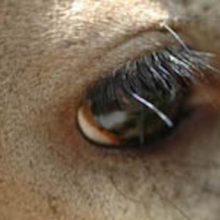BY BOB MCNITT AND DR. WILLIAM W. MILLER
Understanding How Deer See Will Affect How You Hunt Them
Anyone who hunts deer quickly learns that the animal’s primary survival tool is its remarkable ability to accurately detect and identify even the most subtle smells. Let a deer pick up your scent and it’s game over. And benefiting from its mobile, oversized ears, it can quickly detect the slightest of sounds — such as clothing brushing against a small branch as a hunter moves, or the click of a gun’s safety being released. Given, the deer’s sense of smell and hearing (to a lesser extent) is far superior to ours, but what about its eyesight? How does it really see the world, especially when compared to what we see? Can deer see orange? Are they color blind? Do they see in just black and white? Is their vision good or poor?
Realtree asked one of the nation’s foremost experts on animal ophthalmology — the study and treatment of animal eye diseases and traits — Dr. William W. Miller, professor of veterinary ophthalmology at Mississippi State University. Miller is also an avid deer hunter.
DEER EYE ANATOMY
“To understand what deer see you have to know a little bit about the anatomy of their eyes,” Miller says. “Let’s begin with the front of the eye and work our way to the back. The front of the eye is the cornea. The cornea is clear and serves as the window through which light enters the eye. Like most herbivores (cows, elk, horses) deer have a large cornea that allows a maximum amount of light to enter the eye. Its large size provides for a wide field of view, giving optimum peripheral vision.
“The next aid to the deer’s vision is the pupil, the opening in the iris through which light passes to reach the retina. Since deer are herbivores, they graze or browse. The pupil of the deer, like those of cattle, elk, sheep, and caribou, for example, are oval or rectangular with the long axis of the pupil parallel to the horizon. You have to remember deer and the other examples are prey species, or designed to be eaten by predators.”
Learn more about what dear really see here
